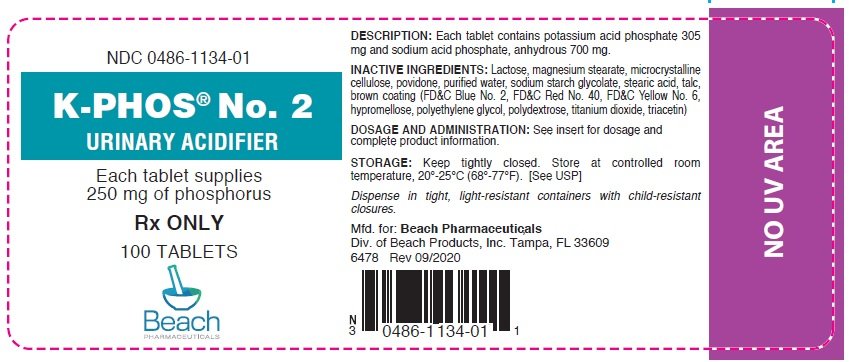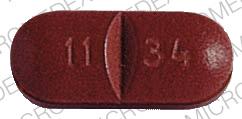K-PHOS No. 2: Package Insert / Prescribing Info
Package insert / product label
Generic name: potassium phosphate, monobasic and sodium phosphate, monobasic, anhydrous
Dosage form: tablet, coated
Drug class: Minerals and electrolytes
Medically reviewed by Drugs.com. Last updated on Mar 5, 2023.
On This Page
K-PHOS No. 2 Description
Each tablet contains potassium acid phosphate 305 mg and sodium acid phosphate, anhydrous, 700 mg. Each tablet yields approximately 250 mg of phosphorus, 88 mg of potassium or 2.3 mEq and 134 mg of sodium or 5.8 mEq.
K-PHOS No. 2 - Clinical Pharmacology
Phosphorus has a number of important functions in the biochemistry of the body. The bulk of the body's phosphorus is located in the bones, where it plays a key role in osteoblastic and osteoclastic activities. Enzymatically catalyzed phosphate-transfer reactions are numerous and vital in the metabolism of carbohydrate, lipid and protein, and a proper concentration of the anion is of primary importance in assuring an orderly biochemical sequence. In addition, phosphorus plays an important role in modifying steady-state tissue concentrations of calcium. Phosphate ions are important buffers of the intracellular fluid, and also play a primary role in the renal excretion of hydrogen ion.
Oral administration of inorganic phosphates increases serum phosphate levels. Phosphates lower urinary calcium levels in idiopathic hypercalciuria.
In general, in adults, about two thirds of the ingested phosphate is absorbed from the bowel, most of which is rapidly excreted into the urine.
Indications and Usage for K-PHOS No. 2
K-PHOS® No. 2 is a highly effective urinary acidifier for use in patients with elevated urinary pH. This product helps keep calcium soluble and reduces odor and rash caused by ammoniacal urine. Also, by acidifying the urine, it increases the antibacterial activity of methenamine mandelate and methenamine hippurate.
Contraindications
This product is contraindicated in patients with infected phosphate stones, in patients with severely impaired renal function (less than 30% of normal) and in the presence of hyperphosphatemia.
Precautions
General
This product contains potassium and sodium and should be used with caution if regulation of these elements is desired. Occasionally, some individuals may experience a mild laxative effect during the first few days of phosphate therapy. If laxation persists to an unpleasant degree, reduce the daily dosage until this effect subsides or, if necessary, discontinue the use of this product.
Use of this medication should be carefully considered when the following medical problems exist: Cardiac disease (particularly in digitalized patients), Addison's disease, acute dehydration, extensive tissue breakdown, myotonia congenita, cardiac failure, cirrhosis of the liver or severe hepatic disease, peripheral and pulmonary edema, hypernatremia, hypertension, toxemia of pregnancy, hypoparathyroidism, and acute pancreatitis. Rickets may benefit from phosphate therapy, but caution should be observed. High serum phosphate levels increase the risk of extraskeletal calcification.
Information for Patients
Patients with kidney stones may pass old stones when phosphate therapy is started and should be warned of this possibility. Patients should be advised to avoid the use of antacids containing aluminum, magnesium, or calcium which may prevent the absorption of phosphate.
Laboratory Tests
Careful monitoring of renal function and serum calcium, phosphorus, potassium and sodium may be required at periodic intervals during phosphate therapy. Other tests may be warranted in some patients, depending on conditions.
Drug Interactions
The use of antacids containing magnesium, aluminum, or calcium in conjunction with phosphate preparations may bind the phosphate and prevent its absorption. Concurrent use of antihypertensives, especially diazoxide, guanethidine, hydralazine, methyldopa, or rauwolfia alkaloid; or corticosteroids, especially mineralocorticoids or corticotropin, with sodium phosphate may result in hypernatremia. Potassium-containing medications or potassium-sparing diuretics may cause hyperkalemia when used wi t h potassium phosphate. Patients should have serum potassium level determinations at periodic intervals. Plasma levels of salicylates may be increased since salicylate excretion is decreased in acidified urine. Administration of monobasic phosphates to patients stabilized on salicylates may lead to toxic salicylate levels.
Carcinogenesis, Mutagenesis, Impairment of Fertility
No long-term or reproduction studies in animals or humans have been performed with K-PHOS® No. 2 to evaluate its carcinogenic, mutagenic, or impairment of fertility potential.
Pregnancy
Teratogenic Effects
Pregnancy Category C
Animal reproduction studies have not been conducted with K-PHOS® No. 2. It is also not known whether this product can cause fetal harm when administered to a pregnant woman or can affect reproductive capacity. This product should be given to a pregnant woman only if clearly needed.
Adverse Reactions/Side Effects
Gastrointestinal upset (diarrhea, nausea, stomach pain and vomiting) may occur with phosphate therapy. Also, bone and joint pain (possible phosphate-induced osteomalacia) could occur. The following adverse effects may be observed (primarily from sodium or potassium): headaches; dizziness; mental confusion; seizures; weakness or heaviness of legs; unusual tiredness or weakness; muscle cramps; numbness, tingling, pain, or weakness of hands or feet; numbness or tingling around lips; fast or irregular heartbeat; shortness of breath or troubled breathing; swelling of feet or lower legs; unusual weight gain; low urine output; unusual thirst.
K-PHOS No. 2 Dosage and Administration
One tablet four times daily with a full glass of water. When the urine is difficult to acidify, administer one tablet every two hours not to exceed 8 tablets in a 24-hour period.
How is K-PHOS No. 2 supplied
K-PHOS® No.2 is supplied as a brown, scored, capsule-shaped tablet with the name BEACH and the number 1134 imprinted on each tablet. Bottles of 100 (NDC 0486- 1134-01).
| K-PHOS
NO. 2
potassium phosphate, monobasic and sodium phosphate, monobasic, anhydrous tablet, coated |
||||||||||||||||||||||||||||||||||||
|
||||||||||||||||||||||||||||||||||||
|
||||||||||||||||||||||||||||||||||||
|
||||||||||||||||||||||||||||||||||||
|
||||||||||||||||||||||||||||||||||||
|
||||||||||||||||||||||||||||||||||||
|
||||||||||||||||||||||||||||||||||||
| Labeler - Beach Products, Inc. (032763633) |
| Establishment | |||
| Name | Address | ID/FEI | Business Operations |
|---|---|---|---|
| LGM Pharma Solutions, LLC | 117549200 | manufacture(0486-1134) | |
More about K-Phos No. 2 (potassium phosphate / sodium phosphate)
- Check interactions
- Compare alternatives
- Pricing & coupons
- Drug images
- Side effects
- Dosage information
- During pregnancy
- Drug class: minerals and electrolytes
- En español
Patient resources
Professional resources
Other brands
Phospha 250 Neutral, K-Phos Neutral


